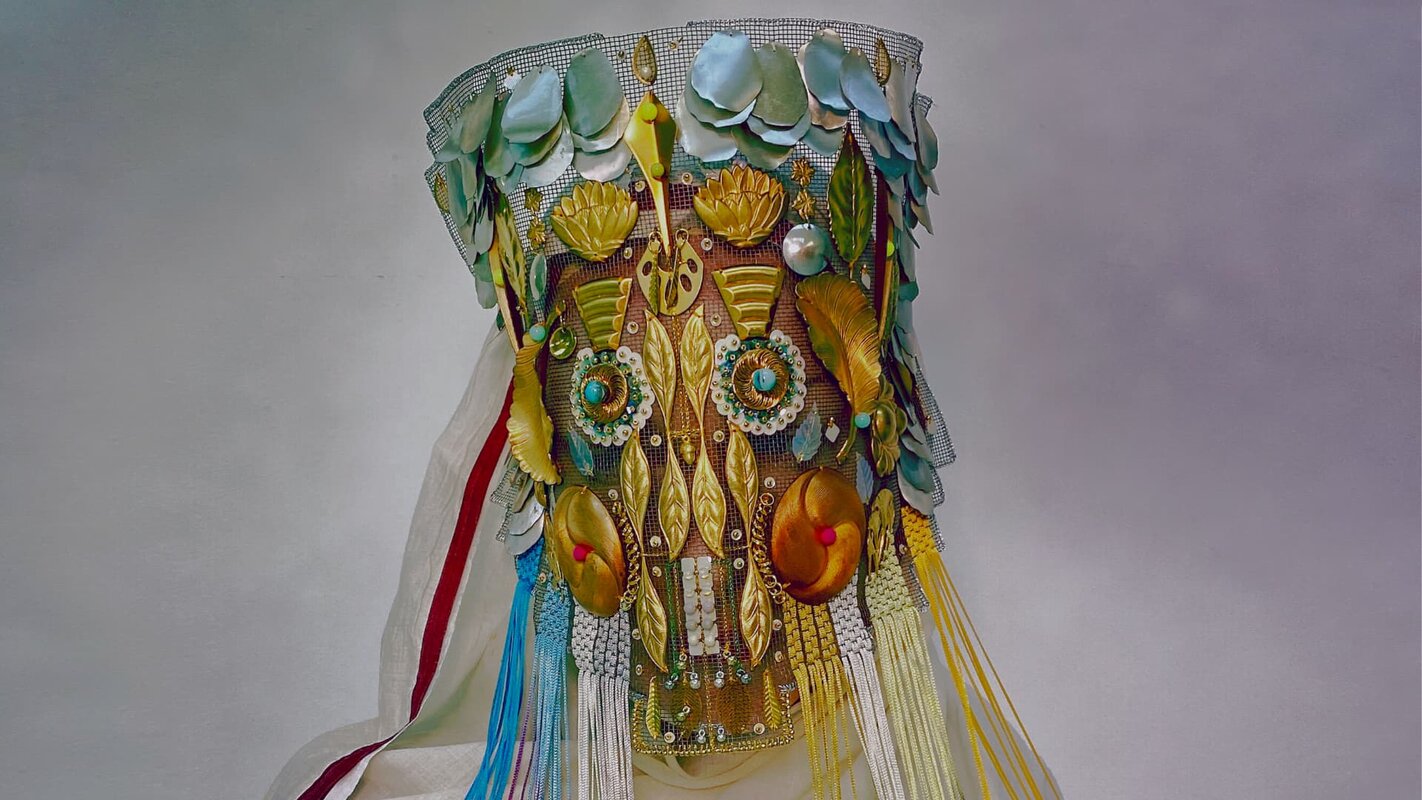
Damselfrau: Masks That Work for Themselves
Magnhild Kennedy is a mask maker from Norway, living and working in London. She works under the acronym Damselfrau. The Norwegian word ‘damsel’ means unmarried woman and the German ‘Frau’ means woman, historically implying being married. She combines the two words to mean ‘married to oneself’. She has collaborated with many artists from the realm of fashion, editorial, art, music and performance.
Pictoplasma: We would like to jump right into your work and talk about the names you give your masks. Do you remember why these names came up and if they mean anything? For example, Totsee (2020).
Magnhild Kennedy: That’s just short for ‘to the sea’. It’s because there are nautical elements in the mask. There's coral and brass ornaments that are in the shape of different sea creatures and plants.
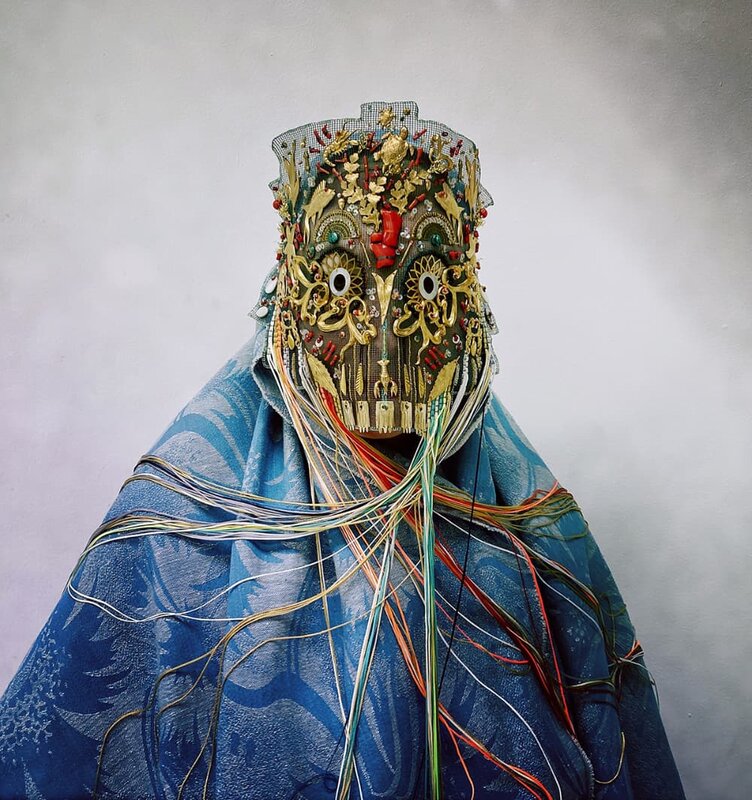
So, these names float into your head in the process of making, in response to certain materials?
No, they show up at the end. I don't think about anything whilst I work. At the end, I look at it and something clear always pops up, then I just fish into that. Say it looks like an owl; what's the Latin word for an owl? I will find the Latin word for an owl. Then change letters so it's not too literal. Maybe it needs more vocals in it, or is it an ‘over-toney’ mask or an ‘under-toney’ mask? Does it need some kind of high-note to it? So I put the double ‘ee’ in the title. It all depends. It's just a question of taste; the exercise of naming them. I try to stay away from literal stuff but sometimes it's just too clear and you can't look away from it.
"I don't look at them as persons or identities."
Do the names help to give each mask a certain identity or do you not think in terms of identity?
I don't really. Not for me! Because I make a lot, and they're here in boxes laying on top of each other. What are they to me? I think of them like scales that I grow and shed, something like that. I don't look at them as persons or identities. That happens when other people use them. They're not even really masks for me until someone else puts them into action or projects onto them. I will take that on, of course, when I have the experience of someone else having an experience. Then that will imprint on that piece and remain in there.
What are they to you before they turn into masks through the action of people wearing them?
Just residue. I got into this because of materials. I like the textile experience, the meditative experience. I like texture and colours. For me, it's just about organizing materials. Obviously it is a mask, but I've never had a big interest in masks as the principal category. Therefore, it's rather a question of luck that a mask comes out. Quite often I'm surprised that it's functional because I let myself be directed by whatever the material is telling me, and that isn't always functional.
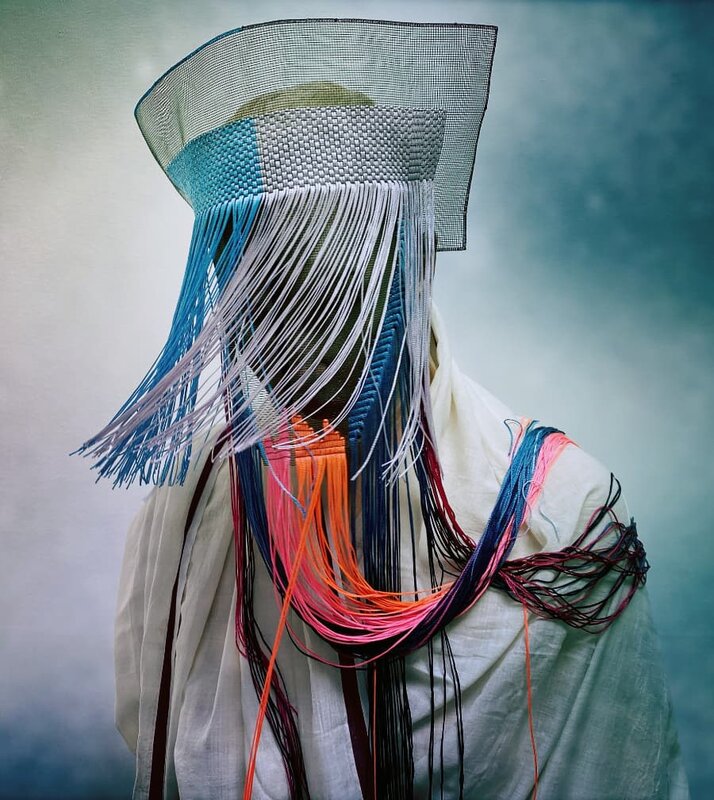
There's no drawings, no concept, no sketch?
No, I collect a lot of stuff and have lots of boxes with the stuff that I try to organize. Then I just put my hands in there, feel for what feels good, taste-wise and look-wise. It's a different process when I work for someone under commission. Then there's projection from the beginning. This is a whole different process. I often find it quite troublesome because it's not as playful as when I just fiddle around for myself. But that pressure also comes with interesting outcomes that I really like. It's just two very different processes. Both are enjoyable at the end.
"I really like the ghosts of stuff."
Those processes where you just play with the material… some of the material has had a meaning before; you took it from somewhere or it has a history. How important is that for you? Do you sometimes have an object that feels so fascinating, you have to do something with it?
Absolutely. In the beginning, I started with stuff that had previously functioned as something. I still really like taking apart old clothes and things. My friends bring me things from their travels or something they had in their family. Firstly, it comes with wear, and that's already personality. I can just surf on that, ride on that, and use that information to go faster with what I'm doing. I've always been into stuff that’s old because I really like the ghosts of stuff. I don’t mean in a mumbo-jumbo way, but I like the feeling of something having been somewhere. That will absolutely inform what I'm doing, will help show me the direction of where the piece is heading. There's often a ghost of the original thing in the mask, it'll have a wink to what it used to be. That will just happen naturally. I don’t do it consciously. I try to think as little as possible when I do this.
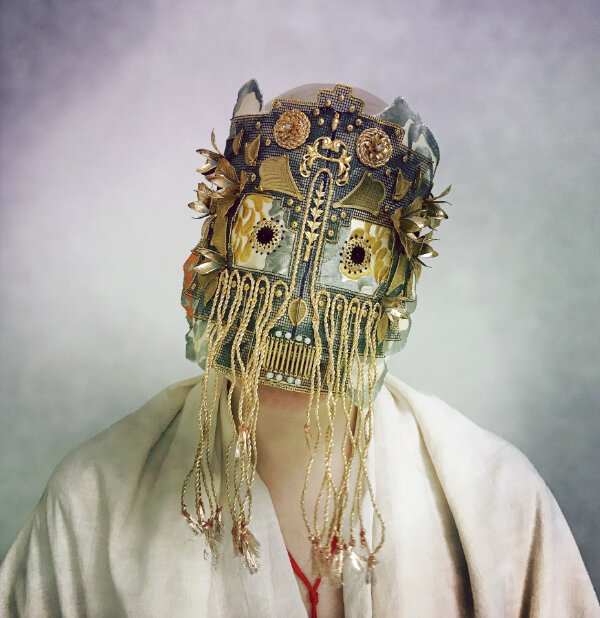
There's a profound difference between the face and the mask. Some people say there's no real face and the mask is not a betrayal but just another face. Do you think about these things, and where does the magic happen for you in terms of the relationship between face and mask?
It happens when another person wears the mask. I take a picture of it on myself once it's finished and that pretty much rounds up the process of making it. That also provides a conduit to the Internet; I post the image on my different platforms. After that, I never put them on again. That would feel almost incestuous. So, I say; ‘Oh, I'm done with that’. But when other people put them into effect, if someone else wears it or photographs it, that's when it becomes a mask. It's their projection that tells me what I'm doing. I'm not that obsessed with the object as a mask until someone else does that for me.
"It's important for me to keep it super light, very crisp, very playful"
And in that moment, what happens? What kind of transformation process is that?
I don't know if I can put it into words. It's not a fundamental experience. I'm on the surface all the time. I never really dive down. I'm not a patient person. I have a tendency to leave projects unfinished, and I don't know how this project has managed to continue for eleven years! I think that's just because I let it be, just keep it light. I'm not letting it demand anything from me. I am just so grateful that it turned into work because other people make it into work for me. I'm just playing in this project. It's important for me to keep it super light, very crisp, very playful and not think too much.
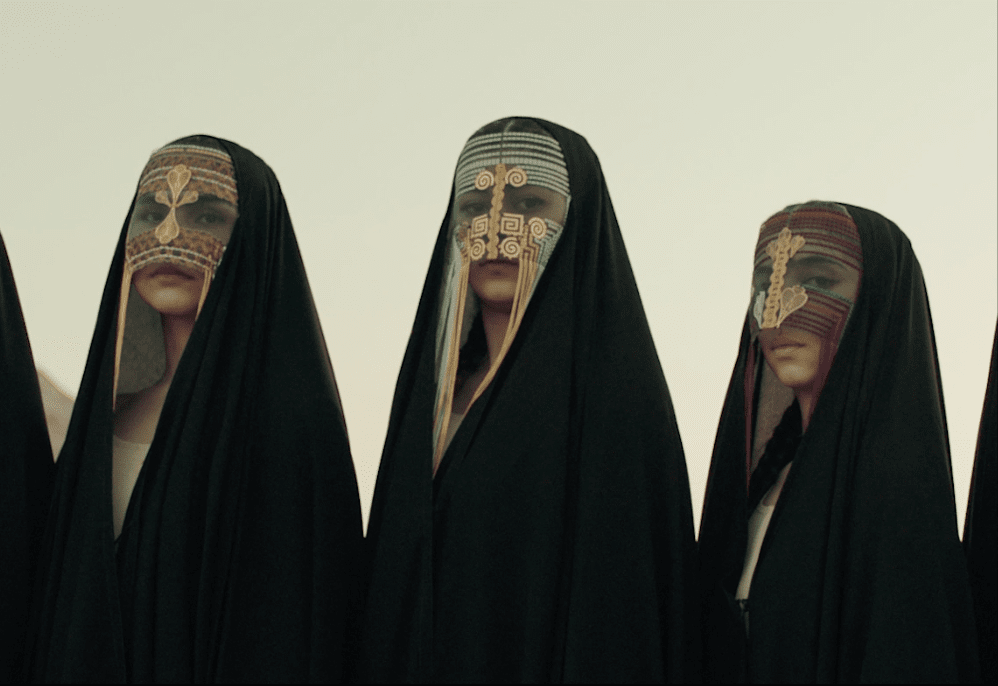
"The masks work for themselves. I can trust their work."
Another question on that process: You make it, it becomes a mask, you take a photo. In the first phase, it’s all about touching and the materiality, as you don't make sketches first. It’s playing with the material. But when we perceive it, what's important to the outside world are the images. That's where it happens. But for you, the important thing is the material.
I like the image part of it too. I didn't know that it could be like that; the work lending itself so easily to making images. My biggest form of communication happens online. My smartphone is my third arm, I'm on it all the time. The image stuff has become the form of communication. That's where they become real identities, which again has nothing to do with me; that happens out there. They work for themselves. I can trust their work because they do good work for themselves. It is obviously removed from the really tactile place of origin. This later stage is a very different universe and very removed from the original piece. I like both. I like the multidimensionality, that there are so many sides to it where the masks communicate differently. Of course, the important thing is the stuff in the real world. I do shows once in a while, which me and my husband produce ourselves, just to be able to see that the masks can also meet with people in the flesh and do the same kind of job they do on the Internet. But the Internet is super important for me.
"I went from zero to a hundred in the way that I took in information and got inspired."
Let's get back to a time when the Internet wasn't what it was today. Let's go back to the year 2007, around the time that you arrived in London and started going clubbing. Can you tell us how that fed into what you're doing now?
We moved from Oslo, and I'm from Trondheim – which is even smaller – to land in London! At that time there was a lot of fashion clubbing, there was this really pumping scene. There was a club called Boombox that was just outrageous; fashion stuff I'd never seen before! People making costumes out of egg cartons and tape, and making it into high-fashion couture. This stuff was so informative for me. I went from zero to a hundred in the way that I took in information and got inspired.
At the same time, my first job was at a vintage designer store called Pallet London in Islington. It stocked lots of couture stuff from the 1940s, 50s and 60s. My boss was very nice to me. He let me sit and do my little stitching stuff behind the till whilst I was looking at all these beautiful old clothes. Some of them were falling apart, and I'd mend them, often learning as I went along. I'd never learned anything technical in terms of working with textiles before. This hadn’t really interested me. I learned about materials and how to work with them, and that led to my first small projects. I was stitching behind the till and that's where the masks started to show up, maybe just because of space restrictions.
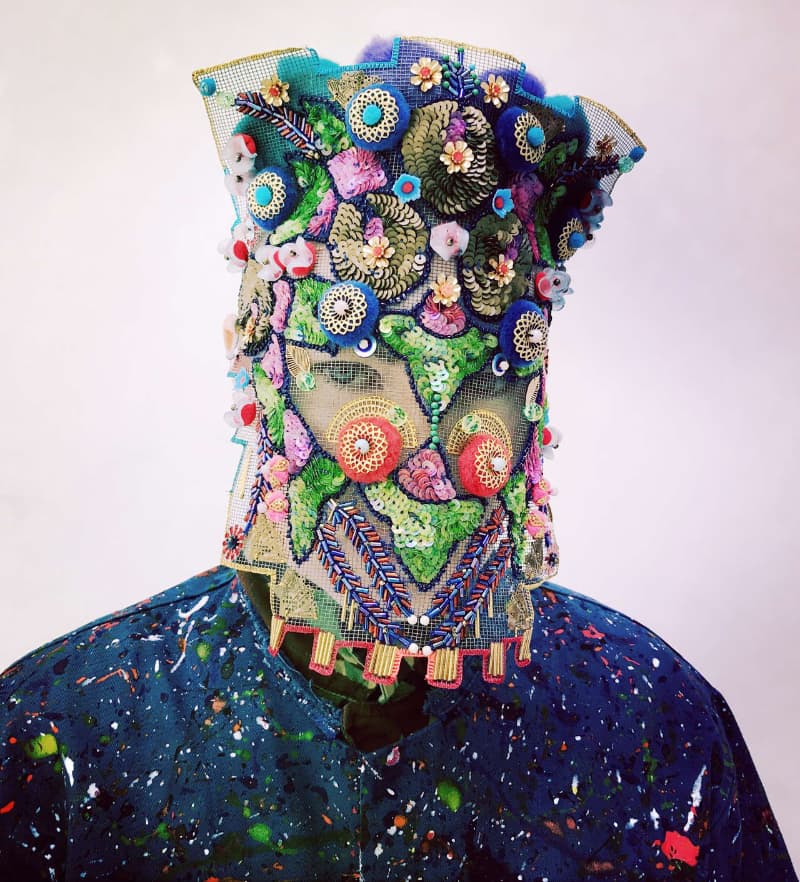
In 2012, I cracked the code a little. The few years before had been a bit lacey, a little more sexy; I hadn't found my language, I was just learning technique and finding my footing. I made one piece that was green with some tassels and embroidery. That's probably the most important piece in my whole body of work because when I was making that, I knew that I'd landed. I'd found a space where I could own the work, where I was hoping that it could be work. The shift happened quite early on, and the last eight years have felt quite consistent. I was already at home in the work.
Now you're doing a lot of collaborations. Let’s take a look at these. You work with artists, fashion editorial, with music people, theatre... how does that happen and what does it do to your masks or your objects?
I never search out these collaborations myself. Again, this reflects how I try to keep it really light and easy without trying to determine where the work should go. That's just hoping the work will do that for itself. As I’ve said before, the Internet is where I communicate. The masks communicate, so they fix their own jobs.
"It’s always nice to be part of something that I think is really cool."
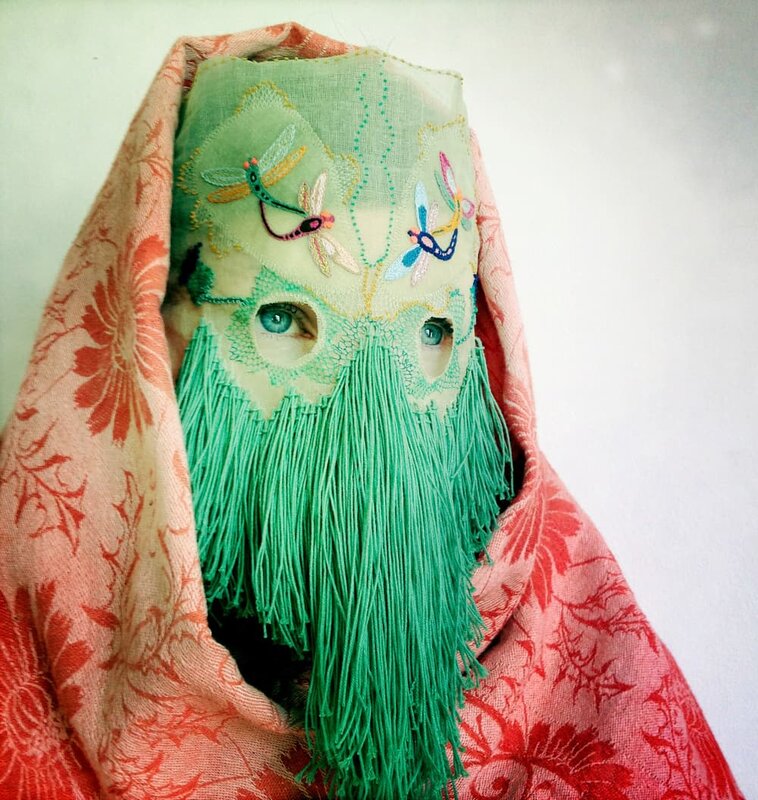
It's always delightful when you see the final product. Then you feel you've communicated, you've connected to the person wearing it and connected to the project. I love it when the musician Mentrix shows up. She's making a video in Iran in the most beautiful scenery and wants me to make stuff based on traditional headwear there. I find this really difficult because I have very little knowledge of this headwear and culture, so I have to get into that. Seeing that work and being in touch with a culture I know very little of is such a learning curve and makes me have so much more faith in my work. It's such an experience of growth every time, whatever the project.
Interview by Pictoplasma published in Pictoplasma Magazin – Issue 1: Face Value, 2021
- 300 views
- 0x empathy